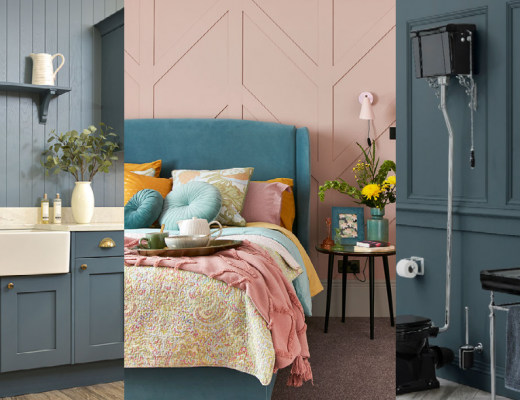Are you planning a kitchen renovation and can’t decide which layout to go for? KBB journo Charlotte Luxford discusses the pros and cons of open-plan living to help you achieve a successful scheme…
But first, what is an open-plan kitchen layout? It is one seamless, interconnected space achieved by removing physical barriers between the different functional living zones.
While open-plan layouts naturally go hand in hand with modern-day family life, in a post-pandemic world some homeowners are reverting to a more divided, broken-plan design as they crave quieter spaces away from the hubbub of the communal kitchen.

With working from home now the norm, and many of us spending more time at home, there’s an argument that the broken plan is the way forward. However, many designers maintain that it’s simply a matter of individual preferences, lifestyle considerations and household dynamics.
Read on to discover the pros and cons of open-plan kitchens…

The pros of the open-plan kitchen
An open-plan layout works especially well when the architectural character of a property lends itself to generous proportions and spaces, particularly kitchen extensions.
Features including high ceilings, large floor-to-ceiling glazing with garden views and exposed beams truly come into their own in an open-plan layout, enhancing the character and sense of spaciousness. And by removing walls that would have acted like a barrier, the natural light from windows and rooflights can flood the open-plan space seamlessly, creating a brighter and airier space.

If you prioritise communal activities, an open-plan layout is a winning formula, particularly for families with younger children, enabling you to keep an eye on them while attending to daily tasks. “Open-plan living is incredibly functional because it allows everyone to be in the moment at the same time,” says Will Durrant, owner of Herringbone Kitchens.
“Families will naturally gather in the living, dining and kitchen areas even if taking part in solo activities like reading, watching TV and doing homework, which creates a lovely feeling of togetherness.” It also works well for hosting, allowing the chef to chat with guests while simultaneously prepping meals.
How to make this layout work
Designing an open-plan kitchen relies heavily on having the space. So, that might require reconfiguring rooms if your floor plan doesn’t originally allow for it. “If you’re looking to open up a room, providing it’s a supporting wall it’s often cheaper to knock down than to work around it with tiles or paint,” says Al Bruce, founder of Olive & Barr. “If you do need to knock down a supporting wall, a common and expensive mistake is hiring an architect. A structural engineer can give you all the information you need.”

Once you have your blank canvas, whether that’s a reconfiguration or extension, the secret behind making an open-plan layout comfortable, practical and characterful is effective zoning. This can be achieved with furniture, lighting and colour schemes to create distinct areas within the open space.
So, a large rug or a change in flooring can define the living space, while pendant lights can create a focal point for the dining area. Layers and texture are key to creating defined spaces, as well as making it still feel warm, intimate and welcoming.

Storage is also vital to the success of an open-plan scheme. A single-run kitchen with a bank of floor-to-ceiling cupboards along one wall and an island to help separate the cooking zone works well, or an L-shaped kitchen layout with a small peninsula is also effective.
Don’t feel all the cabinetry in the room has to match as it’ll create a one-dimensional look. Mix painted furniture with raw timber, antique with new, gloss finishes with matt, and add plenty of soft furnishings in varying patterns to keep it feeling chic and interesting.

What to watch out for
Lastly, while open-plan layouts have their merits, they also come with a set of challenges. One significant drawback is the potential for noise and lack of privacy. The open nature of the space can lead to sound travelling freely, impacting different activities within the same area. A noisy dishwasher or washing machine rumbling in the background when entertaining can be irritating, so look for appliances with a Quiet Mark seal of approval to minimise noise.
Clutter is another problem that can easily creep up on you, so you’ve got to be pretty organised about tidying up or include plenty of clever storage solutions that can conceal the majority behind closed doors. Elements such as pull-out larders, banquette seating with storage, dresser units, sideboards and media walls with integrated bookshelves and cupboards will help maintain a calm and mess-free look.




